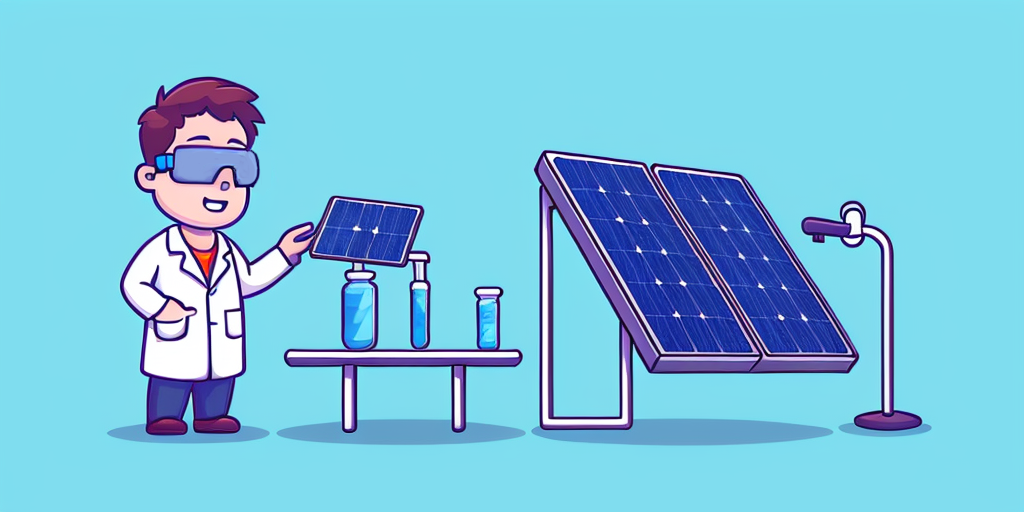Picture a world where the blazing hot summer pavement turns into a clean energy source. In this fantasy, our planet’s infinite miles of highways would be turned from lifeless, heat-trapping surfaces into a massive network of solar energy generators. This concept, known as solar roadways, envisions our streets, highways, and parking lots as a giant linked power grid capable of supplying renewable energy to our homes, cities, and even entire countries. Many people around the world have been captivated by this concept, which has spurred optimism for a more sustainable and efficient future.
Solar roadways are a daring and ambitious notion that promises to address some of our time’s most serious issues, such as climate change, energy security, and infrastructure development. In this article, we’ll look at the origins of the solar roadways concept, from the enthusiastic and ambitious 2014 “Solar Freakin Roadways” video to the current state of the technology, to see if it’s still too good to be true or if it has the potential to revolutionize how we generate and consume energy.
Solar Roadways is an innovative solar technology that tries to convert regular asphalt roads into energy-generating surfaces by using solar panels. The primary idea is to replace traditional road surfaces with long-lasting, modular solar panels that can sustain car weight while converting sunshine into electricity. These highways have the ability to create clean, renewable energy, cut greenhouse gas emissions, and even melt snow and ice during the winter.
Solar Roadways Inc, the startup behind this ambitious initiative, was founded in 2006 by Scott and Julie Brusaw. Their goal was to transform the way we create and consume energy by harnessing the power of the sun using existing infrastructure – our highways. With millions of miles of road around the world, the potential for energy production is huge if the concept is proven to be feasible.
The notion of solar highways takes a multifaceted approach to addressing some of today’s most pressing issues, such as climate change, air pollution, and the ever-increasing demand for energy. Solar roadways can successfully transform enormous expanses of otherwise worthless land into significant sources of clean energy by reinventing the function of roads and other surfaces. This novel technology not only generates electricity, but it also has the ability to lessen the urban heat island effect by absorbing and utilizing sunlight that would otherwise be absorbed by the asphalt and heat up our cities.
The solar panels used in these roadways are built to be strong, long-lasting, and able to resist the constant pressure and friction of vehicles passing over them. The panels are made of high-strength materials and have a rough surface to offer traction for automobiles. The modular architecture enables simple installation, maintenance, and replacement of individual panels as needed. Furthermore, these panels can be embedded with sensors and communication systems, allowing them to act as “smart” highways capable of monitoring traffic, weather conditions, and even charging electric vehicles as they drive.
Solar highways have the potential to increase both motorist and pedestrian safety and convenience. The use of LED lights within the panels allows for the direct display of traffic lines, signals, and warnings on the road surface, giving drivers real-time information and lowering the chance of accidents. Solar panels in colder climates can be outfitted with heating components that melt snow and ice on the road, making winter driving safer and lowering the need for salt and snowplows.
Overall, solar highways are a daring and forward-thinking solution to turn our existing infrastructure into a sustainable and efficient system for generating renewable energy. Solar roadways have the potential to alter the way we think about energy generation and consumption in the twenty-first century by tapping into the huge potential of the world’s roads and other surfaces.

Solar Roadways first received international notice in 2014 thanks to their viral video named “Solar Freakin Roadways,” which introduced the concept in an entertaining and enthusiastic manner, catching millions’ imaginations and getting over 24 million views on YouTube. The video emphasized the potential benefits of solar highways, including sustainable energy production, less reliance on fossil fuels, and increased traffic safety.
This focus resulted in major funding for the project. Solar Roadways raised nearly $2.2 million in 2014 through an Indiegogo crowdfunding campaign. They also received funding from the United States’s Department of Transportation, with a $100,000 funding in 2009, followed by a $750,000 award in 2011 for additional development and testing.
Since its inception in 2006 by the Idaho-based company Solar Roadways, the concept of solar highways has grown dramatically. The founders imagined a future in which roadways, parking lots, driveways, and other ground-level surfaces could be converted into renewable energy sources by replacing typical asphalt with long-lasting, solar-panel-embedded surfaces. Let’s take a closer look at the benefits and promises of Solar Roadways Inc.’s solar roadways.
Solar Roadways claims that their road panels are weatherproof and have a 20-year lifespan, which is longer than the normal 10-year lifespan of asphalt roads. The requirement for road repairs and maintenance would be reduced, potentially saving money in the long run.
Over the years, Solar Roadways has received celebrity endorsements, 50,000 donors’ crowdfunding, government research awards, and over $6 million in capital raised, including $2.5 million from a 2021 StartEngine campaign. It’s vital to distinguish between Solar Roadways Inc. and the notion of solar roadways. As mentioned before, other groups and efforts are looking into solar road panels and comparable items.
Solar Roadways has done testing and experimental projects to assess the viability and practicality of their concept since the initial excitement produced by the viral film. As a proof of concept, they built a modest 150-square-foot solar roadway near Sandpoint, Idaho, in 2016. This project revealed the ability of solar highways to generate power, but it also highlighted several issues, including high installation and maintenance costs, as well as lesser energy efficiency compared to typical solar installations.

Solar highways have also been tested in other nations. In 2017, France opened the Wattway, a one-kilometer stretch of solar roadway that was the world’s first. However, the project encountered various difficulties, including damaged solar panels, lower-than-expected energy production, and a €5 million price tag. Similarly, China launched a one-kilometer solar road in Jinan in 2018, although it too had issues such as damaged solar panels and theft.
Sweden has approached the idea of integrating energy generating with road infrastructure in a significantly different way. The government debuted the world’s first electrified road in 2018, a 2-kilometer stretch near Stockholm that is designed to charge electric vehicles as they drive. This proposal employs an electric rail implanted in the road surface that connects to a movable arm on the vehicle’s bottom to provide a continuous supply of electricity. While this unique idea does not directly use solar power, it highlights the potential of novelly combining energy generation and transportation infrastructure, and it may be integrated with solar energy sources to create a fully sustainable transportation system.
The Solar Tunnel project in Belgium, which was finished in 2011, is another example of international interest in solar highways. This 3.6-kilometer-long tunnel is covered with 16,000 solar panels, which generate enough electricity to power 4,000 households. While not strictly speaking a solar roadway, this project demonstrates the feasibility of integrating solar energy generation with traffic infrastructure on a big scale.
These multinational initiatives show that countries all over the world are actively researching and investing in novel ways to connect renewable energy generation with transportation infrastructure. These countries’ different initiatives, such as solar roadways, electrified roads, and solar tunnels, illustrate the potential for such integrated systems to contribute to a cleaner, more sustainable future. As additional countries develop and test these technologies, we may witness the emergence of innovative solutions and best practices that may be implemented globally to further promote renewable energy and sustainable transportation adoption.
Although the concept of solar highways is clearly enticing, it has encountered a number of severe hurdles. One of the main concerns is the longevity and efficiency of solar panels, which must survive vehicle weight and abrasion. Furthermore, solar panels on highways are less efficient than those on rooftops because they are frequently at an inefficient angle for gathering sunlight. Not to mention, engineers have struggled to produce solar road panels that can endure the pressure of heavy automobiles while yet allowing sunshine to penetrate.
Another major issue is the expensive cost of installation and upkeep. The expense of replacing standard road surfaces with solar panels is significant, as is the cost of maintaining these panels due to the constant wear and tear they are subjected to. Some experts believe that the funds spent on solar highways would be better spent on other renewable energy solutions, such as rooftop solar or wind power, which have higher efficiency and lower costs. Because solar road panels are integrated into the road, they cannot be cooled by air circulation, limiting solar panel efficiency as temperatures rise over acceptable levels.
However, supporters of solar highways believe that solutions to these problems can be developed. Advances in solar panel technology, for example, could result in more robust and efficient panels that can resist the pressures of road use. Additionally, as the technology improves and becomes more generally adopted, economies of scale may assist to reduce installation and maintenance costs.
Despite the obstacles that solar highways face, some governments continue to invest in and study the technology’s potential. Since 2014, the Netherlands has been testing solar bike routes dubbed SolaRoad. The initiative has yielded positive results, with the bike route producing more energy than anticipated. South Korea debuted a 2-kilometer solar bike lane in 2018 that runs down the center of a highway, providing shade for bikers while also generating electricity.

Japan has also expressed interest in solar highways, completing a demonstration project along the Tokyo Expressway in 2018. Despite the challenges that early implementations faced, these multinational endeavors demonstrate the persistent interest in the potential of solar highways.
Solar highways continue to be an exciting and novel concept with the potential to transform how we generate and consume energy. While early pilot projects encountered various obstacles, ongoing investment and research into the technology show that interest in solar highways remains strong.
As solar panel technology evolves and more pilot projects are carried out around the world, we may be able to overcome the current restrictions and make solar highways a viable and efficient source of renewable energy. For the time being, solar highways are a fascinating concept that has yet to be fully proven as a practical, cost-effective solution to our energy needs.
Solar highways have the potential to have both economic and environmental benefits if they are adopted on a big scale. Solar roads, by providing clean, renewable energy, could help reduce our reliance on fossil fuels and cut greenhouse gas emissions, thus mitigating climate change. Furthermore, the energy created by solar highways might be fed back into the grid, lowering the demand for electricity supplied by traditional power plants.
Not to mention, solar highways may spur job growth in the renewable energy sector. The solar roadway business would provide new job opportunities throughout the board, from production and installation to maintenance and research. Furthermore, because solar road panels are predicted to last longer than typical asphalt roads, broad adoption of solar roadways might significantly minimize the expenses associated with road repairs and maintenance.
The economic and environmental benefits of solar roads, however, must be balanced against the costs and obstacles of their development, installation, and maintenance. Solar highways, as previously noted, confront challenges in terms of efficiency, durability, and cost-effectiveness. While technology developments and economies of scale may help overcome some of these challenges, it is unclear whether solar highways will eventually surpass other renewable energy sources in terms of return on investment and environmental impact.
Solar highways are only one innovative solution to making our road infrastructure more sustainable and efficient. Several more developing technologies are being investigated, with the potential to provide benefits and efficiencies in road transportation. These technologies include, for example:
Along with solar highways, these emerging technologies highlight the possibility for redesigning our road infrastructure to enable a more sustainable, efficient, and environmentally friendly future.
Millions have been captivated by the concept of solar highways, which has spurred optimism for a cleaner, more sustainable future. The idea has come a long way, from the famous “Solar Freakin Roadways” video to many trial projects throughout the world, but it still confronts considerable obstacles in terms of efficiency, durability, and cost. We may be getting closer to realizing the full potential of solar highways as technology advances and more study is undertaken. For the time being, it remains an ambitious notion that has yet to deliver the game-changing solution that many had hoped for. Nonetheless, the pursuit of this new notion emphasizes the need of investigating and investing in alternative clean energy sources as we seek for a more sustainable future.
Solar roadway critics have expressed worries about their cost-effectiveness, longevity, and safety. Some claim that other renewable energy sources, such as wind and solar farms, are more efficient and cost-effective.
A few solar highways have been erected as experimental projects around the world, including in the Netherlands, France, and China. Solar highways, on the other hand, are still in their early phases of general usage.
Solar roadways generate power by absorbing sunlight and converting it using solar panels embedded in the pavement. This electricity can then power homes, businesses, and electric vehicles.
Stay a while and read more posts like this
In recent years, Europe has witnessed a remarkable surge in the adoption of solar panels, marking a pivotal shift towards renewable energy. Data from the...
Renewable Energy, Solar Energy, Solar Energy Basics, Solar Technology
“Unlock the Truth: Get the Facts on Solar Energy!” Introduction Solar energy is becoming increasingly popular as a renewable energy source, but there are...
Imagine a world where you’re able to cut your monthly energy expenditure substantially. A reality where your home isn’t reliant on finite,...